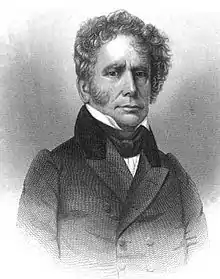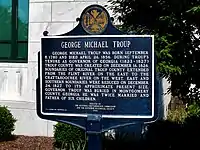George Troup
George McIntosh Troup (September 8, 1780 – April 26, 1856) was an American politician from the U.S. state of Georgia. He served in the Georgia General Assembly, U.S. House of Representatives, and he U.S. Senate before becoming the 32nd Governor of Georgia for two terms and then returning to the U.S. Senate. A believer in expansionist Manifest Destiny policies and a supporter of native Indian removal, Troup was born to planters and supported slavery throughout his career. Later in his life, he was known as "the Hercules of states' rights."
George McIntosh Troup | |
|---|---|
 | |
| United States Senator from Georgia | |
| In office March 4, 1829 – November 8, 1833 | |
| Preceded by | Oliver H. Prince |
| Succeeded by | John P. King |
| In office November 13, 1816 – September 23, 1818 | |
| Preceded by | William W. Bibb |
| Succeeded by | John Forsyth |
| 32nd Governor of Georgia | |
| In office November 7, 1823 – November 7, 1827 | |
| Preceded by | John Clark |
| Succeeded by | John Forsyth |
| Member of the U.S. House of Representatives from Georgia's At-large district | |
| In office March 4, 1807 – March 3, 1815 | |
| Preceded by | David Meriwether |
| Succeeded by | Wilson Lumpkin |
| Member of the Georgia General Assembly | |
| In office 1803-1805 | |
| Personal details | |
| Born | September 8, 1780 McIntosh Bluff, Alabama |
| Died | April 26, 1856 (aged 75) Treutlen County, Georgia |
| Political party | Democratic-Republican, Democratic |
| Spouse(s) | Anne St. Clair McCormick Anne Carter |
| Alma mater | College of New Jersey |
Family life
Troup was born during the American Revolution at McIntosh Bluff, on the Tombigbee River in what is now Alabama (then a part of the Province of Georgia). He was the son of George Troup and Catherine McIntosh, the Georgia-born daughter of Captain John McIntosh, a British military officer and the chief of the McIntosh clan. (Catherine McIntosh was of the Chiefs of the MacGillivary clan lineage—she was a first cousin to Creek Chief Alexander McGillivray and aunt of Creek Chief William McIntosh.)
Troup was twice married and the father of six children. He primarily lived in Dublin in Laurens County. Troup's plantation, Valdosta (sometimes spelled Val d'Osta), was named after the Valle d'Aosta alpine valley in Italy. In turn, the town of Valdosta, Georgia was named for Troup's plantation. Troupville, Georgia was also named for him.
Troup graduated from the College of New Jersey (later Princeton University) in 1797. He read the law with an established firm and two years later was admitted to the bar in Savannah, Georgia.
Early career
Troup entered politics, where he became a strong opponent of the Yazoo land scandal. A Democratic-Republican, Troup served one term as a state legislator (1803–1805). In 1806 he was elected to the U.S. House of Representatives, and was re-elected a total of four terms, serving until 1815. Along with fellow western Congressmen such as Henry Clay of Kentucky and John C. Calhoun of South Carolina, Troup was a part of the nationalistic movement which originated the term War Hawks who supported the United States' entry into the War of 1812.[1] Troup defended Calhoun on the House floor when Rep. John Randolph of Roanoke of Virginia attacked Calhoun, Troup said after all, it was "the great mass of the House ... against the solitary gentleman from Virginia."[2]
Troup was elected to the U.S. Senate, where he was supported by fellow wealthy plantation owners and served as chairman of the Senate Committee of Military Affairs.
Governorship of Georgia
Georgia political force William H. Crawford hand-picked Troup as his candidate for governor in 1819. However, Troup twice lost to Crawford's bitter rival, John Clark, who was supported by frontier settlers. In 1823, Troup ran again, as Clark was no longer eligible, and won. He advocated the removal of the Creek Indians from western Georgia. Troup wanted to move them to the Western Territory of the Louisiana Purchase, an idea first proposed by Thomas Jefferson in 1803. In 1825, in Georgia's first popular election, Troup won by a razor-thin margin. He negotiated the controversial Treaty of Indian Springs on February 12, 1825,[3] with his first cousin William McIntosh, a mixed-blood Creek chief.[4] McIntosh and 49 other tribal leaders (predominantly from the Lower Creeks) ceded a large portion of Georgia, although they did not have the backing of the majority of the Creek Confederacy. He threatened an attack on Federal troops if they interfered with the treaty and challenged President John Quincy Adams,[5] who conceded and allowed Troup to seize the remaining Creek land in Georgia.[6] During Troup's tenure as governor, he also supported public education and the construction of new roads and canals.
Later career
Upon the expiration of his second term as governor, Troup returned to the Senate in 1829 as a Jacksonian Democrat, where he served on the Committee on Indian Affairs. He was a nominee for President of the United States at the States Rights Convention in January 1852 in Jackson, Mississippi.
Death and memorialization

Troup died while visiting one of his plantations near the Oconee River in Montgomery County, Georgia (now Treutlen County).[7] He was buried on the Rosemont plantation.[8]
Troup County was created from former Lower Creek land in 1826 and named for him.
During the American Civil War, an Athens, Georgia battery was named the "Troup Artillery" in his memory.
See also
- Hofwyl-Broadfield Plantation, owned by his brother
Footnotes
- Schoen, Brian (2009). The fragile fabric of Union : cotton, federal politics, and the global origins of the Civil War. Baltimore: Johns Hopkins University Press. p. 98. ISBN 978-0-8018-9303-2.
- Johnson, David E. (2012). John Randolph of Roanoke. Baton Route: Louisiana State University Press. p. 146. ISBN 9780865971509.
- Edel, Charles N. (2015). Nation Builder : John Quincy Adams and the Grand Strategy of the Republic. Cambridge, Massachusetts: Harvard University Press. p. 225. ISBN 9780674368088.
- Rosen, Deborah A. (2015). Border Law. Cambridge, Massachusetts: Harvard University Press. p. 266. ISBN 9780674967618.
- Smithers, Gregory D. (2014). Native diasporas : indigenous identities and settler colonialism in the Americas. Lincoln: University of Nebraska Press. p. 216. ISBN 9780803233638.
- Kaplan, Lewis E. (2009). The beginning of the end of the republic. New York: Algora. p. 110. ISBN 978-0-87586-696-3.
- "Governor Troup's Home historical marker". Digital Library of Georgia. Retrieved 12 June 2016.
- "Gov. Troup's Tomb historical marker". Digital Library of Georgia. Retrieved 12 June 2016.
- United States Congress. "George Troup (id: T000382)". Biographical Directory of the United States Congress.
Further reading
- Harden, Edward Jenkins. The life of George M. Troup. Savannah, 1859.
- Winn, William W. The Triumph of Ecunnau-Nuxulgee: Land Speculators, George M. Troup, State Rights, and the Removal of the Creek Indians from Georgia and Alabama, 1825-38. Macon, GA: Mercer University Press, 2015.
External links
- Georgia State Capitol portrait of Governor Troup
- George Troup's gravesite
- Bust of Troup in the State Capitol Rotunda
- Troup-Clarke Political Feud
| U.S. House of Representatives | ||
|---|---|---|
| Preceded by David Meriwether |
Member of the U.S. House of Representatives from Georgia's at-large congressional district March 4, 1807 – March 3, 1815 |
Succeeded by Wilson Lumpkin |
| U.S. Senate | ||
| Preceded by William W. Bibb |
U.S. senator (Class 2) from Georgia November 13, 1816 – September 23, 1818 Served alongside: Charles Tait |
Succeeded by John Forsyth |
| Preceded by Oliver H. Prince |
U.S. senator (Class 2) from Georgia March 4, 1829 – November 8, 1833 Served alongside: John M. Berrien, John Forsyth |
Succeeded by John P. King |
| Political offices | ||
| Preceded by John Clark |
Governor of Georgia 1823–1827 |
Succeeded by John Forsyth |

